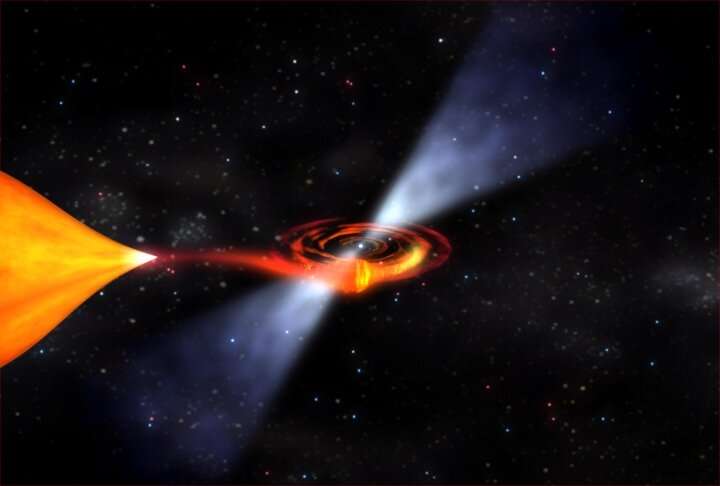Artist's impression of a millisecond pulsar. Credit: NASA.
Astronomers from Australia and Canada have performed a study of an accretion-powered millisecond pulsar known as SAX J1808.4–3658. The new research, provides essential information regarding binary evolution pathway of this system. The findings are detailed in a paper published March 6 on arXiv.org.
The most rapidly rotating pulsars, those with rotation periods below 30 milliseconds, are known as millisecond pulsars (MSPs). It is assumed that they are formed in binary systems when the initially more massive component turns into a neutron star that is then spun-up due to accretion of matter from the secondary star.
SAX J1808.4–3658 is an actively accreting millisecond pulsar (AMSP) in a binary system, which experiences outbursts approximately every four years. To date, about 20 AMSPs have been discovered and SAX J1808.4–3658 is the most well studied and observationally constrained AMSP of its kind.
Although SAX J1808.4–3658 has been a subject of numerous observations in the past and its evolution has been extensively modeled, none of these studies have taken into account the fact that the system's donor star has been shown to be significantly evolved. Hence, Adelle Goodwin of Monash University in Australia, and Tyrone Woods of Herzberg Astronomy and Astrophysics Research Centre in Canada, decided to verify this scenario.
"We modeled the binary evolution of SAX J1808.4–3658, taking into account evidence that the donor star is significantly evolved, and the implications on the initial mass of the donor," the astronomers wrote in the paper.
The research found that the most likely progenitor of the SAX J1808.4–3658 system is a companion star with a mass of about 1.1 solar masses and an initial orbital period between 1.0 and 1.22 days. The estimated mass is therefore greater than the value proposed by previous evolutionary studies of this binary.
According to the astronomers, the results suggest that a significant amount of mass is ejected from the inner Lagrangian point of the SAX J1808.4–3658 system. This could be due to an evaporative wind caused by radiation pressure from the pulsar evaporating the donor star during its quiescence period.
Given that the companion star in SAX J1808.4–3658 has now a mass of about 0.8 solar masses and the system has an orbital period of around 2.01 hours, the researchers calculated that approximately 3.73 billion years is needed in order to evolve to the current status.
"Since the initial primary must have been massive, and evolved very quickly through a common envelope (to bring it in to a short orbit) and a supernova, the timescale we find for the subsequent evolution of the donor is approximately the total present system lifetime, ∼3.7 billion years," the paper reads.
In concluding remarks, the astronomers noted that the binary parameters of SAX J1808.4–3658 indicate that it is a "black widow" millisecond pulsar. In general, the so-called "black widows" belong to class of extreme binary pulsars with semi-degenerate companion stars, dubbed "spider pulsars," and are distinguished by the presence of an extremely low-mass (less than 0.1 solar masses) companion.
Moreover, it was noted that SAX J1808.4–3658 may host a circumbinary disk, however, further observations are needed to confirm this assumption.
More information: The binary evolution of SAX J1808.4-3658: Implications of an evolved donor star, arXiv:2003.02970 [astro-ph.HE] arxiv.org/abs/2003.02970
© 2020 Science X Network
























